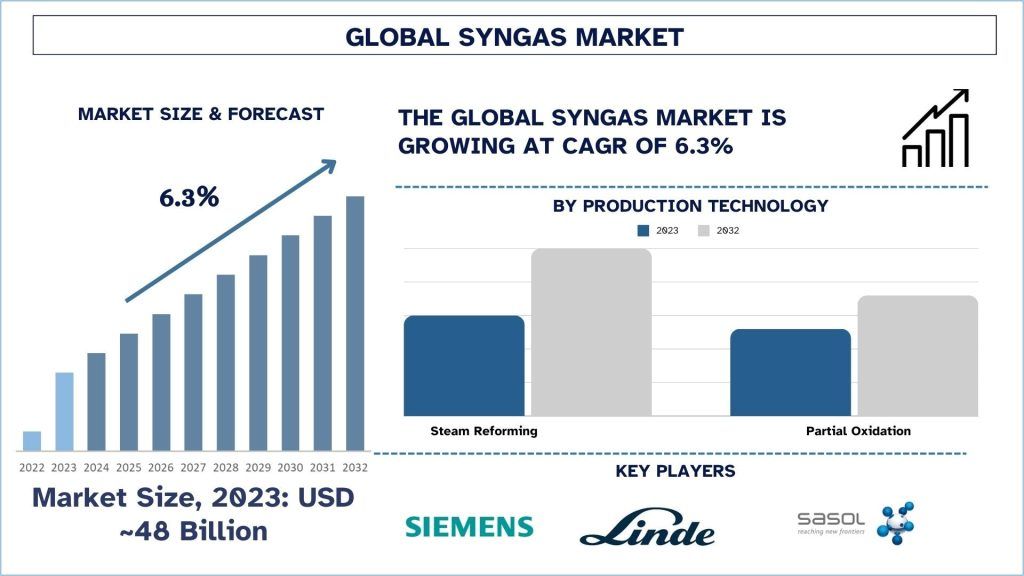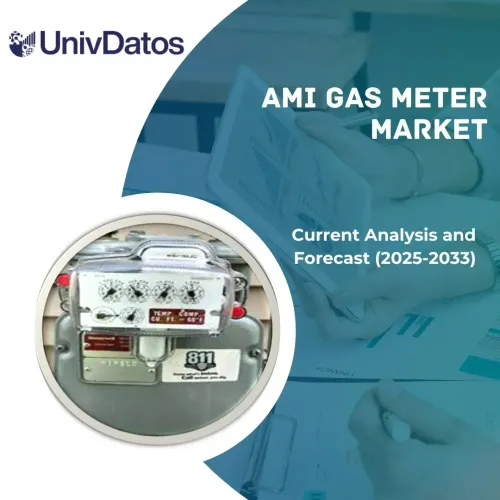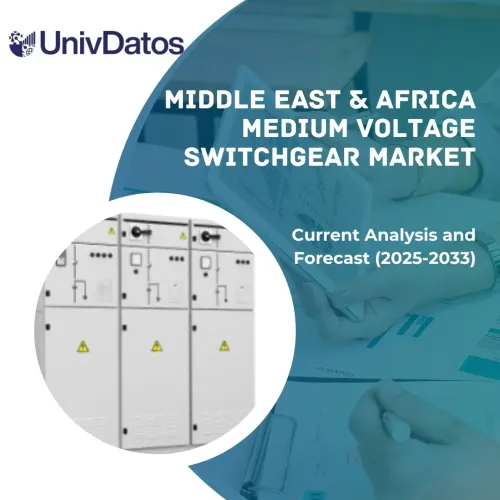- Home
- About Us
- Industry
- Services
- Reading
- Contact Us
Syngas Market: Current Analysis and Forecast (2024-2032)
Emphasis on Production Technology (Steam Reforming and Partial Oxidation), Feedstock (Natural Gas, Coal, Biomass/Waste, and Others); Gasifier Type (fixed Bed Gasifiers, Entrained Flow Gasifiers, Fluidized Bed Gasifiers, and Others); Application (Methanol, Ammonia, Hydrogen, Liquid Fuels, Direct Reduced Iron, Synthetic Natural Gas, Electricity, And Others); Region/Country
Syngas Market Size & Forecast
The Syngas market was valued at USD 48 Billion in 2023 and is expected to grow at a strong CAGR of around 6.3% during the forecast period (2024-2032). The syngas or synthesis gas market proliferates with various uses in chemicals, electricity production, vehicle fuels, and others. Syngas, a combination of hydrogen, carbon monoxide, and carbon dioxide, are usually manufactured by gasifying carbon substances including coal, biomass, or natural gas. Due to its versatility as a feedstock for creating numerous chemical products such as methanol, ammonia, and synthetic natural gas, it plays a crucial role in the global energy and chemicals industry.
Another factor driving the syngas market is the rising concern of global society towards the usage of cleaner sources of energy. Due to its ability to provide for the manufacture of cleaner fuels and cut down on the use of conventional sources of fuel, syngas is highly relevant as governments and industries across the globe focus on tackling the problem of carbon emissions. The use of syngas in power generation, especially in combined cycle power plants makes use of efficient and environmentally friendly systems, which in turn increases demand for syngas.
Syngas Market Analysis
The Syngas market is experiencing enhancements in gasification technologies, which enhance the efficacy and cost-effectiveness of producing syngas. This progress has enhanced the possibility of applying syngas in a broad range of products such as advanced biofuels and chemical synthesis. For example, in 2024, Siemens AG and Boson Energy agreed to accelerate the green energy transition through waste-to-hydrogen technology. Boson gasification-based technology can create syngas with high quality and stability from nonrecyclable solid waste, including municipal solid waste (MSW) with low capital expenditures and operating expenses.
Syngas Market Trends
Advanced Combustion Technologies: The subsequent year, the advancements in next-generation combustion technologies in 2023 enable the flexibility of fuel that boilers have. An example of this is General Electric (GE) Power revealing a next-generation Circulating Fluidized Bed Combustion (CFBC) that enhances fuel-burning efficiency and cuts emissions. This makes this kind of technology ideal for the burning of biomass, coal as well as wastes, in any industrial use.
Digital Integration and Smart Boilers: IoT and AI have revolutionized the use of boilers through the enhancement of their systems. Siemens AG is an example of such companies that have developed smart boiler solutions that incorporate IoT sensors with AI algorithms to help determine the boiler’s efficiency and fuel quality as well as schedule a maintenance check. These smart boilers improve production rates, minimize time losses, and give effective data to make improved decisions.
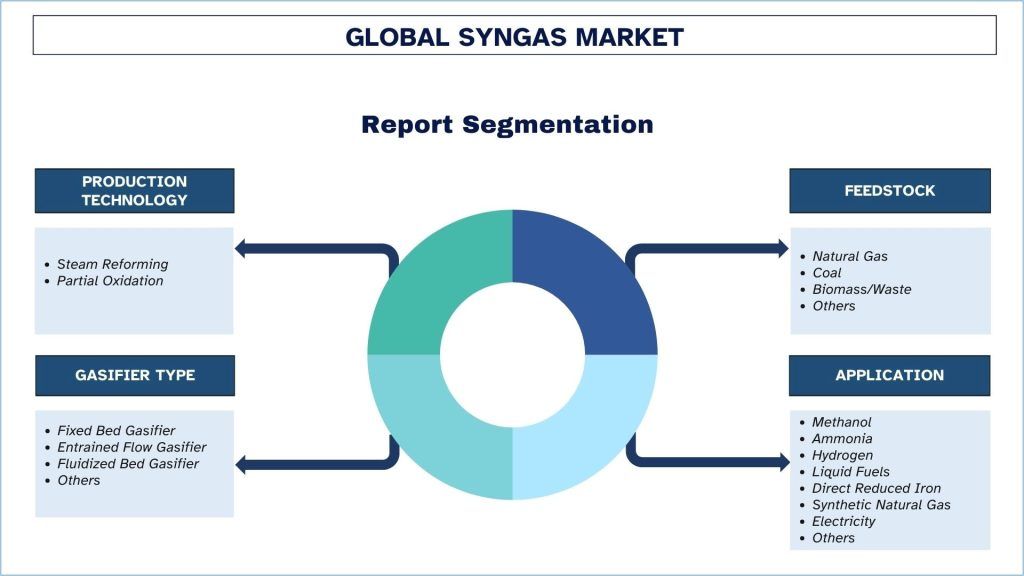
Asia Pacific is Expected to Grow with Significant CAGR During Forecast Period
Asia-Pacific has significantly contributed to the expansion of the Syngas market. This is mainly due to the high industrialization rate, rising energy consumption rates in the region, and a strong industrial focus on the manufacture of chemicals. China and India are leading the pack owing to chemical industries and growing power generation needs. Among the countries, China has the largest share in the syngas market due to the abundance of coal and the government’s plan for less reliance on imported natural gas and oil. Additionally, the emphasis on developing clean power generation in the area, and hydrogen production through syngas, also propels the global market. The increasing trend in industrialization and the increased capital sunk on syngas technologies place Asia Pacific in a strategic position for the global syngas market.
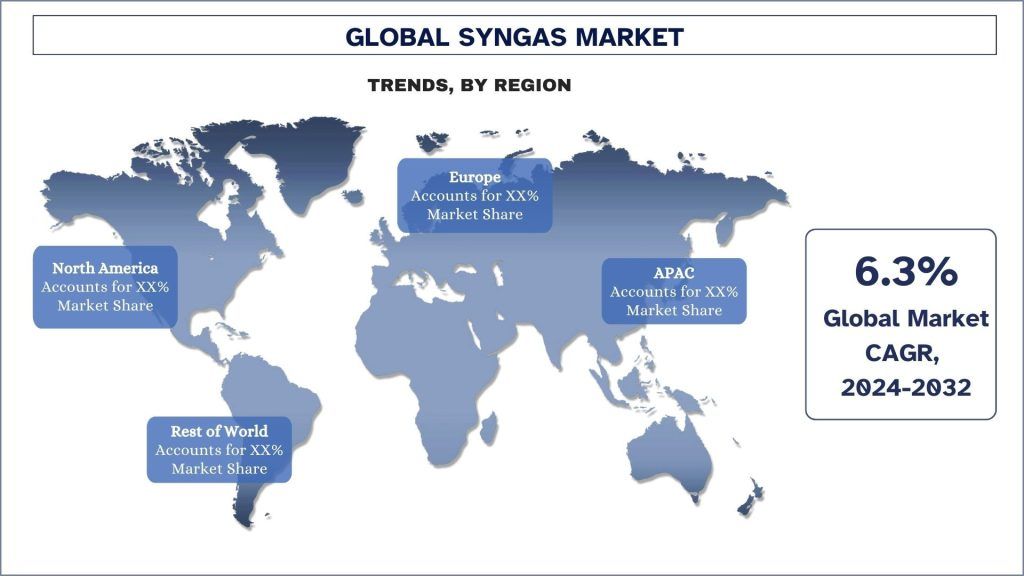
Syngas Industry Overview
- The Syngas market is competitive and fragmented, with the presence of several global and international market players. The key players are adopting different growth strategies to enhance their market presence, such as partnerships, agreements, collaborations, new product launches, geographical expansions, and mergers and acquisitions. Some of the major players operating in the market are Siemens AG, Linde Plc, Sasol, Shell Plc, Topsoe AS, Maire Tecnimont Spa, Dow Inc, Technip Energies NV, Air Products and Chemicals Inc, and Air Liquide.
Syngas Market News
- In 2023, Linde Engineering Signed an Agreement with BASF in China for the engineering, procurement, and construction of a synthesis gas plant.
- In 2023, Sasol Italy and Sonatrach Raffineria Italiana aim to build an innovative plant with significant capacity for the production of hydrogen and ‘low carbon’ syngas. The plant will be capable of capturing and reusing CO2 and will contribute to the decarbonization process of the two sites.
Syngas Market Report Coverage
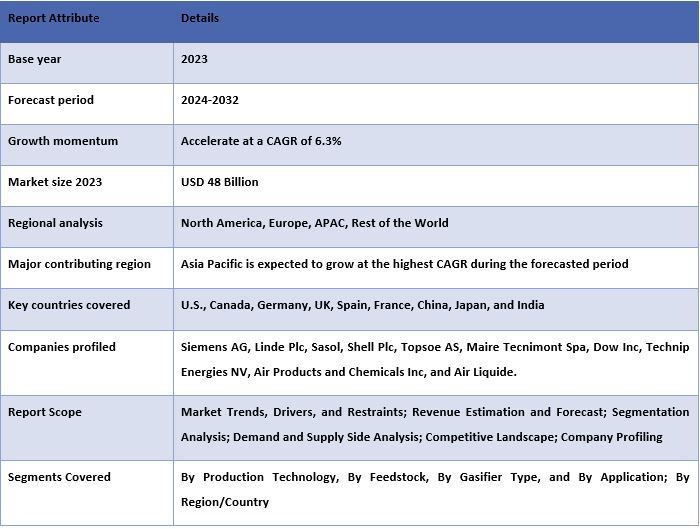
Reasons to buy this report:
- The study includes market sizing and forecasting analysis validated by authenticated key industry experts.
- The report presents a quick review of overall industry performance at one glance.
- The report covers an in-depth analysis of prominent industry peers with a primary focus on key business financials, product portfolios, expansion strategies, and recent developments.
- Detailed examination of drivers, restraints, key trends, and opportunities prevailing in the industry.
- The study comprehensively covers the market across different segments.
- Deep dive regional level analysis of the industry.
Customization Options:
The global Syngas market can further be customized as per the requirement or any other market segment. Besides this, UMI understands that you may have your own business needs, hence feel free to connect with us to get a report that completely suits your requirements.
Table of Content
Research Methodology for the Syngas Market Analysis (2024-2032)
Analyzing the historical market, estimating the current market, and forecasting the future market of the global Syngas market were the three major steps undertaken to create and analyze the adoption of Syngas in major regions globally. Exhaustive secondary research was conducted to collect the historical market numbers and estimate the current market size. Secondly, to validate these insights, numerous findings and assumptions were taken into consideration. Moreover, exhaustive primary interviews were also conducted, with industry experts across the value chain of the global Syngas market. Post assumption and validation of market numbers through primary interviews, we employed a top-down/bottom-up approach to forecasting the complete market size. Thereafter, market breakdown and data triangulation methods were adopted to estimate and analyze the market size of segments and sub-segments of the industry pertains to. Detailed methodology is explained below:
Analysis of Historical Market Size
Step 1: In-Depth Study of Secondary Sources:
A detailed secondary study was conducted to obtain the historical market size of the Syngas market through company internal sources such as annual reports & financial statements, performance presentations, press releases, etc., and external sources including journals, news & articles, government publications, competitor publications, sector reports, third-party database, and other credible publications.
Step 2: Market Segmentation:
After obtaining the historical market size of the Syngas market, we conducted a detailed secondary analysis to gather historical market insights and share for different segments & sub-segments for major regions. Major segments are included in the report as production technology, feedstock, gasifier type, application, and region. Further country-level analyses were conducted to evaluate the overall adoption of testing models in that region.
Step 3: Factor Analysis:
After acquiring the historical market size of different segments and sub-segments, we conducted a detailed factor analysis to estimate the current market size of the Syngas market. Further, we conducted factor analysis using dependent and independent variables such as production technology, feedstock, gasifier type, and application of the Syngas market. A thorough analysis was conducted of demand and supply-side scenarios considering top partnerships, mergers and acquisitions, business expansion, and product launches in the Syngas market sector across the globe.
Current Market Size Estimate & Forecast
Current Market Sizing: Based on actionable insights from the above 3 steps, we arrived at the current market size, key players in the global Syngas market, and market shares of the segments. All the required percentage shares split, and market breakdowns were determined using the above-mentioned secondary approach and were verified through primary interviews.
Estimation & Forecasting: For market estimation and forecast, weights were assigned to varied factors including drivers & trends, restraints, and opportunities available for the stakeholders. After analyzing these factors, relevant forecasting techniques i.e., the top-down/bottom-up approach were applied to arrive at the market forecast 2032 for different segments and sub-segments across the major markets globally. The research methodology adopted to estimate the market size encompasses:
- The industry’s market size, in terms of revenue (USD) and the adoption rate of the Syngas market across the major markets domestically
- All percentage shares, splits, and breakdowns of market segments and sub-segments
- Key players in the global Syngas market regarding products offered. Also, the growth strategies adopted by these players to compete in the fast-growing market.
Market Size and Share Validation
Primary Research: In-depth interviews were conducted with the Key Opinion Leaders (KOLs) including Top Level Executives (CXO/VPs, Sales Head, Marketing Head, Operational Head, Regional Head, Country Head, etc.) across major regions. Primary research findings were then summarized, and statistical analysis was performed to prove the stated hypothesis. Inputs from primary research were consolidated with secondary findings, hence turning information into actionable insights.
Split of Primary Participants in Different Regions
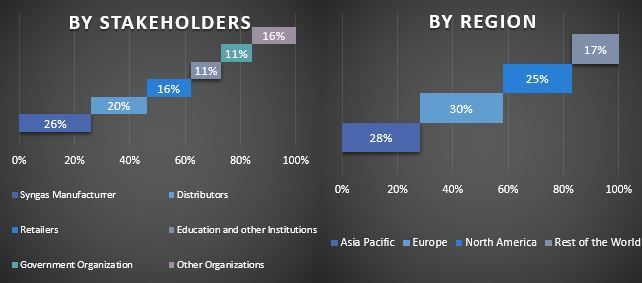
Market Engineering
The data triangulation technique was employed to complete the overall market estimation and to arrive at precise statistical numbers for each segment and sub-segment of the global Syngas market. Data was split into several segments & sub-segments post studying various parameters and trends in the areas of the production technology, feedstock, gasifier type, and application in the global Syngas market.
The main objective of the Global Syngas Market Study
The current & future market trends of the global Syngas market were pinpointed in the study. Investors can gain strategic insights to base their discretion for investments on the qualitative and quantitative analysis performed in the study. Current and future market trends determined the overall attractiveness of the market at a regional level, providing a platform for the industrial participant to exploit the untapped market to benefit from a first-mover advantage. Other quantitative goals of the studies include:
- Analyze the current and forecast market size of the Syngas market in terms of value (USD). Also, analyze the current and forecast market size of different segments and sub-segments.
- Segments in the study include areas of production technology, feedstock, gasifier type, and application.
- Define and analyze the regulatory framework for the Syngas
- Analyze the value chain involved with the presence of various intermediaries, along with analyzing customer and competitor behaviors of the industry.
- Analyze the current and forecast market size of the Syngas market for the major region.
- Major countries of regions studied in the report include Asia Pacific, Europe, North America, and the Rest of the World
- Company profile of the Syngas market and the growth strategies adopted by the market players to sustain in the fast-growing market.
- Deep dive regional level analysis of the industry
Frequently Asked Questions FAQs
Q1: What is the current market size and growth potential of the Syngas market?
Q2: What are the driving factors for the growth of the Syngas market?
Q3: Which segment has the largest share of the Syngas market by Production Technology?
Q4: What are the emerging technologies and trends in the Syngas market?
Q5: Which region will dominate the Syngas market?
Related Reports
Customers who bought this item also bought

